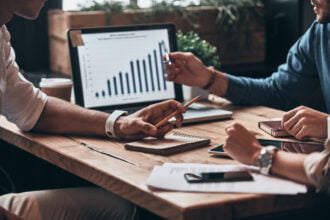An old joke but a question I face each time I am asked gather a team to create a sustainable analytic capability in an organisation. Well I’ve finally collected together my thoughts and I believe I have a model that can be used to plan the resource requirements for a range of analytic objectives.
A couple of things to be aware of if you want to use this:
- It is based on my work with large commercial organisations – those with 1,000 employees or more (sometimes 10’s of thousands more).
- I almost always use specialist BI toolsets such as Business Objects, Cognos, SAS, Informatica, Infosphere, etc.
- My experience has been that the model works equally well for business as usual (BAU), project activities, or a combination of both.
It may be that this model is less applicable outside of the ‘large commercial organisation’ domain – but I don’t yet know why it wouldn’t be. I have used this model across a range of industries and have talked with many people working in many types of non-commercial environments. Nothing they have said has indicated that they have fundamentally different analytic needs from…
An old joke but a question I face each time I am asked gather a team to create a sustainable analytic capability in an organisation. Well I’ve finally collected together my thoughts and I believe I have a model that can be used to plan the resource requirements for a range of analytic objectives.
A couple of things to be aware of if you want to use this:
- It is based on my work with large commercial organisations – those with 1,000 employees or more (sometimes 10’s of thousands more).
- I almost always use specialist BI toolsets such as Business Objects, Cognos, SAS, Informatica, Infosphere, etc.
- My experience has been that the model works equally well for business as usual (BAU), project activities, or a combination of both.
It may be that this model is less applicable outside of the ‘large commercial organisation’ domain – but I don’t yet know why it wouldn’t be. I have used this model across a range of industries and have talked with many people working in many types of non-commercial environments. Nothing they have said has indicated that they have fundamentally different analytic needs from my own. I am interested if anyone reading this has a different opinion.
Anyway, enough prevaricating, here is the resource model:
(Click to open a larger version in a new window)
So the minimum team required for an organisation wanting to have a modest analytic capability is 6 people: A business sponsor and a team of 5:
- Business Subject Matter Expert who understands what the business requires analytics for – what will work, and what wont. This person is also an analytics evangelist (but usually not a ‘tools’ or techniques expert when they start in the role) who will work with the business as a trusted advisor. This is the person that understands the real business requirement for analytics.
- Data Steward who is responsible for data conversion and ongoing quality. This is the person that understands how to deliver business data that is ‘fit for purpose’.
- Data Business Analyst who is able to understand business requirements and create new and original (innovative) solutions to the analytic requirements of the business. This is the person that understands the ‘nature of data’ and can apply this knowledge using diverse tools and techniques like UML, BPR, SQL to give structure and process to the solution.
- Analytics Manager and Technology Solution Architect who manages the analytics team and is the main designer of the technology solution that will be used to deliver analytic products to the business. This is the person that understands how to deliver analytic services.
- Report Writer, help desk and trainer who gets business people to use the analytic solution and then helps support them and further improve the ‘analytic products’.
If you are really, really lucky, then either the Data Business Analyst or the Report Writer also have the skills to use structured analytic techniques. But 9 times out of 10, this isn’t the case. Small team such as the one I describe, are effective at data integration and starting the business in using reports and dashboards for insight. Structured analytic techniques will be important a few years down the track as the organisation’s capabilities grow.
The table below gives you an idea of how these roles become more specialised as the team grows:
(Click to open a larger version in a new window)
So these are the roles and skills that I believe are required if you are to be successful. They do reflect my personal biases for:
- A strong business focus and led approach where IT’s main role is providing the infrastructure platform
- Delivering a self-service analytic capability into the business wherever possible (as opposed to building a large team that provides analytics to the business)
Like the BICC advocated by the Gartners and Forresters of this world, I’m sure that there are a number of models that work. The above is one that has stood the test of time for me.







